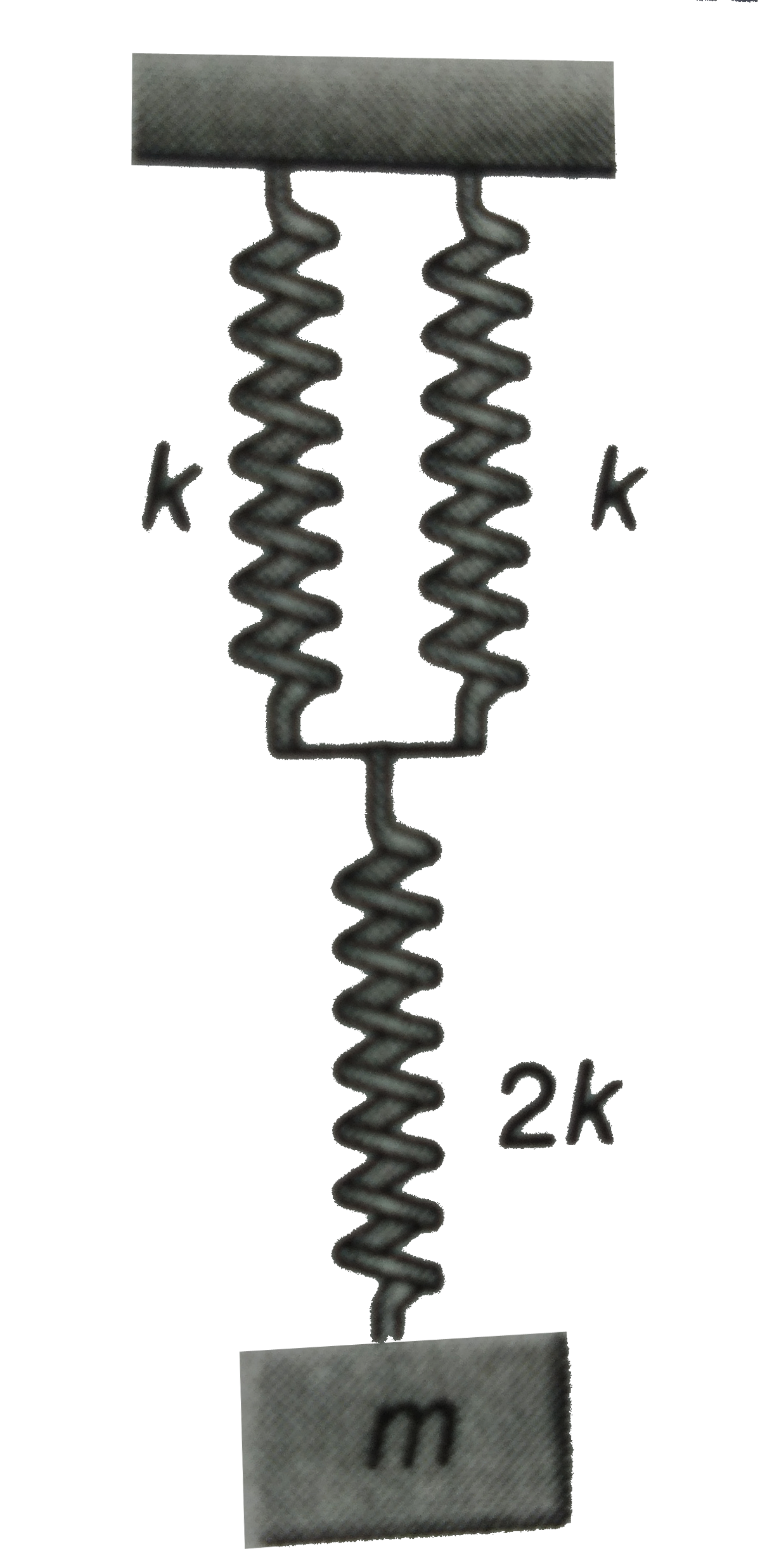A mass M is suspended from a massless spring. An additional mass m stretches the spring further by a distance x. The combined mass will oscillate with a period
2π ⎷{(M+m)xmg}
2π ⎷{mg(M+m)x}
2π ⎷{(M+m)mgx}
π2 ⎷{mg(M+m)x}
The correct Answer is:A
To find the time period of the oscillation of the combined mass suspended from a spring, we can follow these steps:
Step 1: Understand the forces acting on the system
When the additional mass m is added to the mass M, the total force acting on the spring is due to the weight of the combined mass, which is (M+m)g, where g is the acceleration due to gravity.
Step 2: Determine the spring constant k
The spring stretches by a distance x due to the additional mass m. At equilibrium, the force exerted by the spring (which is kx) must balance the weight of the additional mass mg:
kx=mg
From this, we can express the spring constant k:
k=mgx
Step 3: Write the formula for the time period of oscillation
The formula for the time period T of a mass-spring system is given by:
T=2π√mtotalk
where mtotal is the total mass attached to the spring.
Step 4: Substitute the total mass and spring constant into the time period formula
The total mass mtotal is M+m. Substituting k from Step 2 into the time period formula gives:
T=2π√M+mmgx
Step 5: Simplify the expression
This simplifies to:
T=2π√(M+m)xmg
Final Answer
Thus, the time period T of the oscillation of the combined mass is:
T=2π√(M+m)xmg
---
When the additional mass m is added to the mass M, the total force acting on the spring is due to the weight of the combined mass, which is (M+m)g, where g is the acceleration due to gravity.
The spring stretches by a distance x due to the additional mass m. At equilibrium, the force exerted by the spring (which is kx) must balance the weight of the additional mass mg:
kx=mg
From this, we can express the spring constant k:
k=mgx
The formula for the time period T of a mass-spring system is given by:
T=2π√mtotalk
where mtotal is the total mass attached to the spring.
The total mass mtotal is M+m. Substituting k from Step 2 into the time period formula gives:
T=2π√M+mmgx
This simplifies to:
T=2π√(M+m)xmg
Thus, the time period T of the oscillation of the combined mass is:
T=2π√(M+m)xmg
Topper's Solved these Questions
- SIMPLE HARMONIC MOTIONBook:DC PANDEY ENGLISHChapter:SIMPLE HARMONIC MOTIONExercise:Level 1 Subjective
Explore 39 Videos
- SIMPLE HARMONIC MOTIONBook:DC PANDEY ENGLISHChapter:SIMPLE HARMONIC MOTIONExercise:Level 2 Single Correct
Explore 28 Videos
- SIMPLE HARMONIC MOTIONBook:DC PANDEY ENGLISHChapter:SIMPLE HARMONIC MOTIONExercise:Level 1 Assertion And Reason
Explore 10 Videos
- SEMICONDUCTORS AND ELECTRONIC DEVICESBook:DC PANDEY ENGLISHChapter:SEMICONDUCTORS AND ELECTRONIC DEVICESExercise:More than One Option is Correct
Explore 3 Videos
- SOLVD PAPERS 2017 NEET, AIIMS & JIPMERBook:DC PANDEY ENGLISHChapter:SOLVD PAPERS 2017 NEET, AIIMS & JIPMERExercise:Solved paper 2018(JIPMER)
Explore 38 Videos
Similar Questions
Find the period of oscillation of the system shown in figure.

View SolutionA particle of mass 2kg moves in simple harmonic motion and its potential energy U varies with position x as shown. The period of oscillation of the particle is

View SolutionAssertion : In x=Acosωt, x is the displacement measured from extreme position.
Reason : In the above equation x=A at time t=0.
View SolutionWhen an electric field is applied across a semiconductor,
View SolutionIf a machine perform 4000 J output work and 1000 J is inside loss due to friction , then the find efficiency?
View SolutionA mass M is suspended from a massless spring. An additional mass m stretches the spring further by a distance x. The combined mass will oscillate with a period
View SolutionA body of mass m is suspended from a massless spring of natural length l. It stretches the spring through a vertical distance y. The potential energy of the stretched spring is
View SolutionA mass M is suspended from a light spring. An additional mass m added to it displaces the spring further by distance x then its time period is
View SolutionThe period of oscillation of a mass M suspended from a spring of spring constant K is T. the time period of oscillation of combined blocks is
View Solutionएक हल्की स्प्रिंग से M द्रव्यमान लटकाया जाता है। m द्रव्यमान और लटकाने पर इसमें दूरी x की अतिरिक्त वृद्धि हो जाती है। अब संयुक्त द्रव्यमान का इस स्प्रिंग पर दोलनकाल होगा।
View SolutionThe period of oscillation of a mass M suspended from a spring of negligible mass is T. If along with it another mass M is also suspended, the period of oscillation will now be :
View SolutionA mass M is suspended from a light spring. An additional mass m added displaces the spring further by a distance x. Now the combined mass will oscillate on the spring with a period :
View SolutionA mass M is suspended from a light spring. An additional mass m added displaces the spring further by a distance X. Now the combined mass will oscillate on the spring with period.
View SolutionThe period of oscillation of a mass m suspended from a spring of negligible mass is T. If along with it another mass m is also suspended the period of oscillation will now be……..
View SolutionThe oscillation period of mass M suspended from a spring of negligible mass is T. If suspended too, now there will be oscillation period:
View Solution

